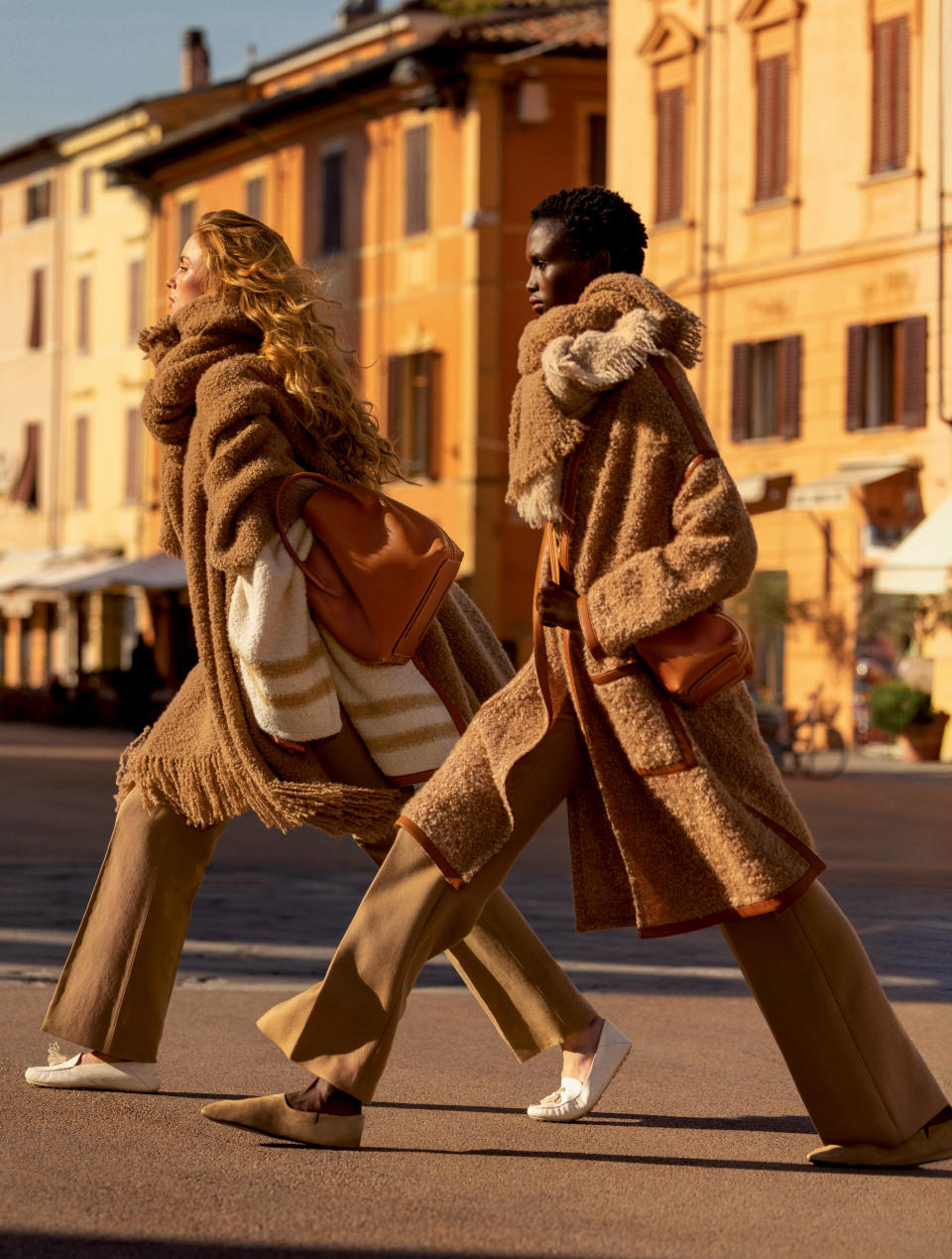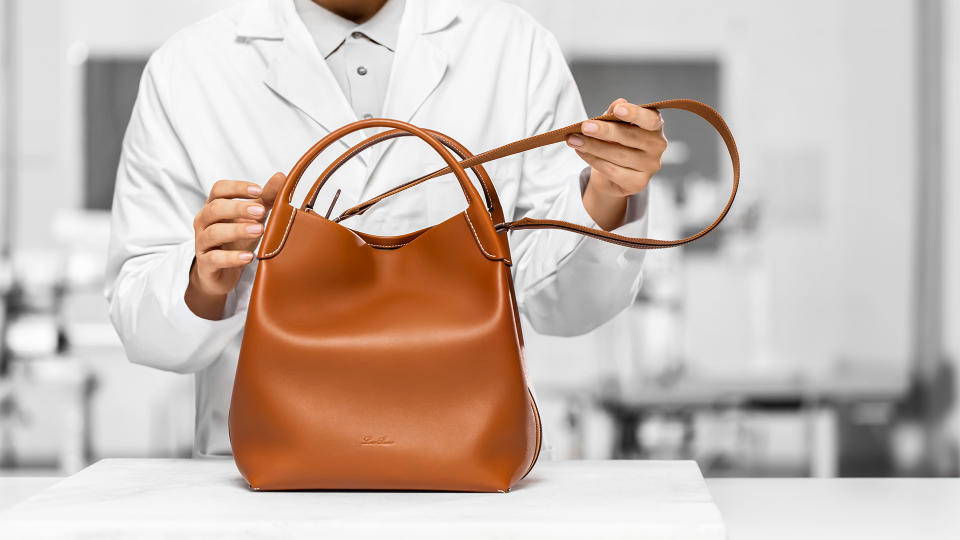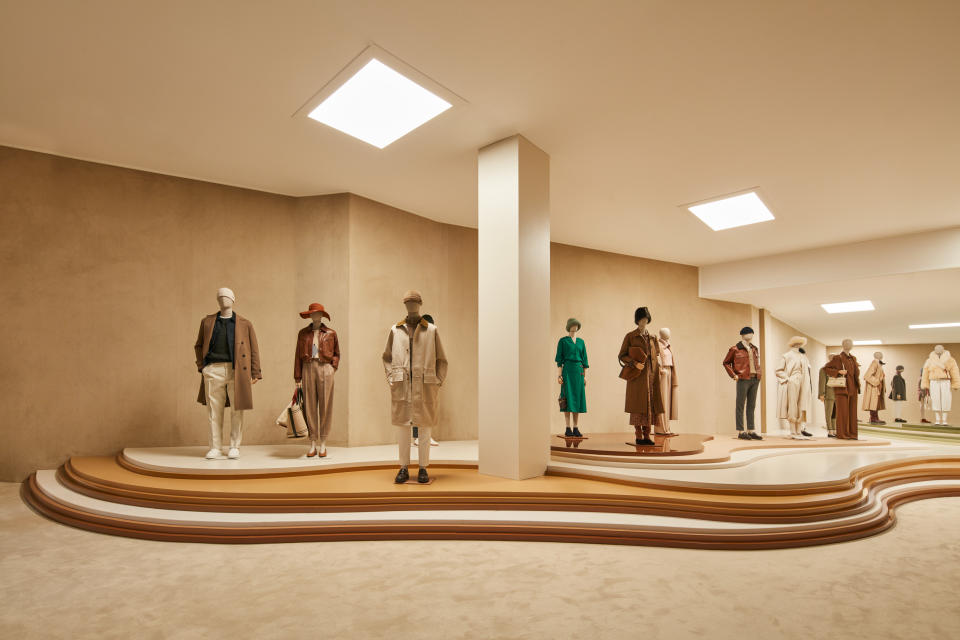CEO Talks: Loro Piana’s Damien Bertrand Maps Out Growth Avenues

MILAN — “Loro Piana for me has the license to try; this is the true luxury.”
In his first, exclusive interview since taking the helm of the Italian brand in November 2021, chief executive officer Damien Bertrand mapped out growth avenues and the untapped potential of Loro Piana.
More from WWD
Bertrand is no stranger to luxury, joining Loro Piana, controlled by LVMH Mo?t Hennessy Louis Vuitton, from Christian Dior Couture in Paris, where he was managing director.
Speaking from his luminous office, personally furnished with distinctive vintage pieces, at Milan’s sprawling Loro Piana headquarters in the newly restored Cortile della Seta real estate development, Bertrand’s passion for the brand is palpable.
A few days earlier, Loro Piana presented its fall collection during Milan Fashion Week, drawing inspiration from the homelands of its key fibers, referencing Peru to honor its vicu?a, Mongolia for its renowned cashmere, and New Zealand and Australia for wool. For the first time, the brand showcased its men’s and women’s lines together. Bertrand enthused about Loro Piana’s contribution to the protection of the endangered vicu?a animal and the research into new fabrics such as CashFur, first employed for outerwear and now also for bags.
Here, Bertrand explains why the brand is “addictive in some way” and why there is no need for a star creative director, as Loro Piana rolls out a new silhouette, and image and communication strategy.
WWD: Let’s talk about the concept of the new collection, because I see there is quite a strong menswear component. Are you expanding the category?
Damien Bertrand: Not necessarily expanding. For me it was important to show for the first time men and women together, because I wanted to show the new silhouette of Loro Piana. I arrived at Loro Piana 15 months ago, which is a long time but not that long, and I wanted to take my time to discover the brand.
First of all, I’m so happy to have joined Loro Piana: it’s an exceptional maison. For me it’s the pinnacle of the Italian luxury, the quintessence of luxury. It was important to discover the heritage, the history, the hundreds of years of history of Loro Piana, which is very interesting and fascinating. Also, I spent time discovering the people, meeting the teams, going into the ateliers, the factories, the shops and I saw and met incredible people. People who are completely passionate and I realized that I could take this amazing resource with me and from the beginning my vision was to say, “We can push them forward as much as we can and we can bring them all together in what I call the new silhouette.”
WWD: Will you describe the new Loro Piana silhouette?
D.B.: It means, perhaps something a bit more modern, more stylish. Beyond man and woman, what is important to me is that for the first time I was able to show you and others this new vision. When you see some of the looks here, I find it very interesting because it is very Loro Piana. [Pointing to the designs displayed in his office.] It’s free, it’s layered, it’s structured, there’s baby cashmere, so it represents very well the beauty and the nobility of the Loro Piana fiber, but at the same time the contrast between the shoes and the trousers is slightly fresher for Loro Piana.
The other element of the silhouette that is very important to me, and you have already mentioned it, is bringing men and women together, developing the collection together, with the same color palette, with the same inspiration, and the result is seen here. The silhouettes speak to each other. The woman’s wardrobe borrows from the men. Some of the jackets you saw were jackets borrowed from the male wardrobe. This is the attitude of the womenswear — a little more spacious, comfortable, beautifully tailored, beautifully layered.
So, for me, my vision and my dream is that we know that Loro Piana is very famous as the master of fiber, but we have to be able to translate that into the silhouette, so that when you walk down the street and you see ladies wearing our garments you think, “Wow, this is so chic, so elegant, so timeless,” this has to be Loro Piana.
WWD: This is that special “Je ne sais quoi…”
D.B.: Exactly, the “Je ne sais quoi,” and so this is what we have been working on together, enjoying and being very proud of what the team has accomplished.
WWD: Does this mean that you have been expanding the team of designers?
D.B.: We have a Loro Piana Studio with a very talented team and designers. We are organized, but we don’t have a studio for men and a studio for ladies: we work for categories of products. We took the time to redefine all the icons of Loro Piana, starting from the spring 2023 collection, re-proposing them in a new key. An example is the Horsey Jacket launched by Sergio Loro Piana in 1992 for the equestrian Italian team of the Barcelona Olympic Games.
[Pointing to the Spagna jacket on a mannequin], this is one of the iconic pieces as well, and we reworked the fit, the details, because Loro Piana is all about detail and so we brought it back to the collection. For me, “icons” do not remain the same forever but need to be animated and re-adapted. It’s the whole look which creates the silhouette. The silhouette is also created through the accessories. The Bale Bag, for example, is made to be worn with the silhouette of the spring collection, so it means that all the pieces are part of a global vision and work well together. It represents who is the Loro Piana lady. They are not separated pieces and they all have a stylistic language that speaks together. It is defined by a style that is modern, contemporary, with a lot of texture and layers, a lot of touch and innovation, and that constitutes what I call the silhouette.
WWD: There is speculation now and again about a star designer joining the company – Phoebe Philo a few months ago was one example. But I gather this is not a strategy you are endorsing?
D.B.: Loro Piana never really had a creative director, so for the moment I don’t think it is needed because the definition of the silhouette has already changed. Then, yes, there are rumors, but they are rumors.
WWD: You spoke of values that touch and speak to you?
D.B.: Heritage, excellence, obsession for quality, tradition, innovation. So, when you take these values even further, for me it’s already something fascinating to do and it’s already a pleasure. Then, when you bring this into a new vision and you see the change, the innovation, for me it is extremely satisfying.
I would say the first moment of this breath of fresh air is with the Cocooning capsule collection. Remember that Loro Piana selects the most beautiful fibers in the world and turns them into masterpieces. And it’s very important to not forget that it takes time. So, to be able within less than one year to bring the Cocooning collection to the market with an amazing success, it’s something that made me very proud.

WWD: When you joined, what do you think was missing and was there something that you really wanted to change?
D.B.: I always knew that Loro Piana had a huge potential, and every day I had the confirmation of that. Every morning when I go to see the team and even yesterday when I went to Porto San Giorgio [in Italy’s central Marche region] to see the new factory, I could see people had stars in their eyes, people proud to work for Loro Piana. When I went to Australia to see the farmers and to see what has been built by the Loro Piana family, by Pier Luigi Loro Piana since many years, it was something very impressive and I felt that I, too, must take care of that.
But to come back to your question, I don’t know if there was something missing, but for me the opportunity in Loro Piana was exactly what I have described and you can see the evolution from the spring collection. I felt we could change the image of our communication and in fact you have seen the evolution of the advertising, to make the representation of the image more modern but at the same time also more varied. When we went live with the new fall campaign on social media, the level of engagement was very high; people responded very positively to this new image. Also, I want to explain more the savoir faire and craftsmanship of Loro Piana because it’s so unique and no one has this level of quality and obsession for quality, which is sustainable.
Clients tell me of products that date back 25 years and they are impeccable. For me this needs to be communicated, so we took a little bit more time to communicate the savoir faire.
We launched CashDenim for the first time last fall, made in collaboration with denim experts from Japan [in the Bingo province]. The beauty of this innovation is that for the first time we brought the expertise of the Japanese hands on denim with our beautiful cashmere and we created this first denim made with 40 percent of cashmere, which is in the inside, so you have the aspect of the denim and the touch of Loro Piana. We did this on old looms that [the makers] have had for more than 70 years. We did it because we believed in it, because it is an innovation and this is also what we communicate as part of our savoir faire and when we put the video on social media it got a lot of views. A lot of people reposted it because people love to understand and people love the innovation, the value.
WWD: Apparently, price is not an issue for the Loro Piana customers, paying for quality.
D.B.: It’s important to have the fair price. For me, quality is paramount at Loro Piana and, as I said before, these items are made to last for your whole life. When you take the philosophy of Loro Piana that consists into sourcing the most beautiful fibers, whether it’s cashmere, whether it’s vicu?a, whether it’s wool, and turn them into masterpieces, in a sustainable way, with the work of more than 1,000 artisans, it’s normal. I think that the best ambassadors are our clients. People are in love with Loro Piana, it makes you feel good, at home, with a beautiful touch on your skin, and at the same time be elegant and cool. So, capsules are a new area of business, like the Cocooning collection. Also, Loro Piana has good potential in accessories, in textile accessories for sure, but also in leather goods. I have lot of confidence in the future.
WWD: You mentioned Porto San Giorgio. What does that factory produce? And how many plants do you have?
D.B.: We make shoes there and we have 10 plants in Italy. Mostly for shoes are in Porto San Giorgio and Porto Sant’ Elpidio; then for leather goods we are in Impruneta, Tuscany; for knitwear and textiles in Piedmont. We are always expanding our facilities. If you look overall, all the categories should grow, not only one of them.
WWD: Are you already thinking about expanding the brand in eyewear or fragrances or is it too early?
D.B.: I often say that Loro Piana is the house of sensation because it touches people. Loro Piana is very particular because it is addictive in some way. It creates this special feeling on you. We could go in many directions, but step by step. My priority now is to establish this new silhouette. And it’s something that I don’t want to do in a rush. Time is important, and creating beautiful things takes time. Loro Piana has a huge potential.
WWD: The textile segment is also key for Loro Piana?
D.B.: It is fundamental. Loro Piana was born by selling textiles, so for me it is something that I want to develop. It’s a fundamental goal. We play with different types of fabrics, different type of combinations, innovation, so the textile part is extremely important for us now. Anyway, the bigger part in terms of sales is the one in the store.

WWD: You have also been developing the design and home categories?
D.B.: Home is another part that I think has a huge potential. We started to accelerate it, and you will see a step forward also in terms of interior in the times to come. Loro Piana is about “art de vivre,” about lifestyle, and this is very important also because the Loro Piana family was obsessed with style. It’s part of a natural evolution of the brand.
WWD: What are your plans for Salone del Mobile and Design Week?
D.B.: It will be very interesting because we are collaborating with Cristián Mohaded, an Argentinian artist and designer, who has a lot of shared values with Loro Piana, and he loves working with craftsmen. He comes from a place that is very close to Loro Piana because that’s where the vicu?a comes from, which is one of the most valuable materials we have. We’ll do the presentation here in the courtyard, but also in the center of the city, and in the store. It’s a 360-degree approach.
WWD: A little bit of business: what is your strategy in terms of distribution?
D.B.: What I can say is that most of the Loro Piana business is represented by Europe [which also includes the Middle East] but we are also working in many markets around the world and we’re seeing a lot of possibilities. We are happy with the result that we received, and we are very confident for the future.
WWD: Are you planning any store openings? How many stores do you have?
D.B.: We now count 162 stores. We are opening a store in Palo Alto [California on Wednesday] and we’re also going to open other stores in Kuwait, China and Thailand.
WWD: Are you planning to change the store concept?
D.B.: We are planning a renovation of the concept that you will start to see in the new openings. For me Loro Piana is about touch and sensorial experience, so the material that we use must represent this and it must be the natural evolution of a concept that lasts for a long time. Clients must enjoy staying in the store, because they stay a lot when they come.
Next year Loro Piana will be 100 years old and part of the objective is to prepare Loro Piana for the next 100 years.

Best of WWD